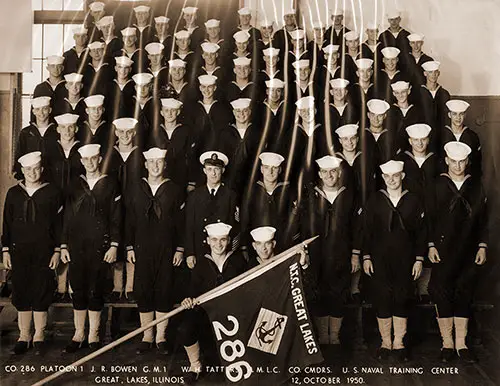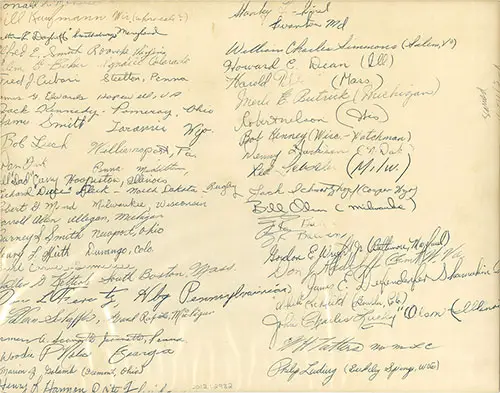USN Great Lakes Company 50-286 Group Photo
Company 286, Platoon 1, Company Commanders: J. R. Bowen, GM1 and W. K. Tatters, MLC at US Naval Training Center, Great Lakes Illinois, 12 October 1950. Photo Courtesy of The National Museum of the American Sailor, Submitted by Charles Dean, 2021. | GGA Image ID # 19f2e1d8d9. Click to View Larger Image.
Howard Charles Dean and was a GM3 and served aboard the USS Timmerman [1] in Boston Mass.from 1950-1954.
Signatures of Sailors in Group Photo
Signatures and Hometown of the Sailors Appearing in the Group Photograph. | GGA Image ID # 19f30d290d
Platoon 1, Company 50-286
- Ron or Donald R. Morrison
- Bill or Will Kaufman (Wisconsin)
- Walter R. Daybeoff (?) (Smithsburg, Maryland)
- Alfred E. Smith (Roanoke, Virginia)
- Clem E. Baker (Colorado)
- Fred J. Cubari (Steelton, Colorado)
- James G. Edwards (Homewell, Virginia)
- Jack Kennedy (Pomeroy, Ohio)
- James Smith (Laramie, Wyoming)
- Bob Leech (Williamsport, Pennsylvania)
- Dan Fritz (?) (Middletown, Pennsylvania)
- Bill or Will "Dad" Curry (Hoopeston, Illinois)
- Richard "Duce" Fleck (Rugby, North Dakota)
- Robert G. Mond (?) (Milwaukee, Wisconsin)
- Carroll Allen (Allegan, Michigan)
- Barney S. Smith (Newport, Ohio)
- Henry L. Keith (?) (Durango, Colorado)
- Burl Carver (Tennesee)
- Walter G. Ketterle (South Boston, Massachusetts)
- Don L. Feretz (?) (Pennsylvania)
- Lavern Schaffer (?) (Grand Rapids, Michigan)
- Harmen A. Scanoth (?) (Jeanette, Pennsylvania)
- Woodie P. Noles (Georgia)
- Marion J. Galamb (Freemont, Ohio)
- Henry L. Harmon (Panama City, Florida)
- Stanley Fichinel (?) (Swanton, Maryland)
- William Charles Simmons (Salem, Virginia)
- Howard C. Dean (Illlinois)
- Harold Tibbetts (Massachusetts)
- Merle E. Butrick (Michigan)
- Robert Nelson (Wisconsin)
- Bob Kenney (Wisconsin)
- Denny Harkison (North Dakota)
- Red Lebsaler (?) (Milwaukee, Wisconsin)
- Jack Schwartzkopf (Casper, Wyoming)
- Bill Olsen (Milwaukee, Wisconsin)
- J. R. Bowen
- Gordon E. Wright, Jr. (Baltimore, Maryland)
- Don J. Radcliff (Freemont, West Virginia)
- James E. Dufendenfer (?) (Shamdkin, Pennsylvania)
- "Slick" Schfeld (Boulder, Colorado)
- John Charles "Lucky" Olson (Illinois)
- W. H. Tatters, MMLC
- Philip Lydwig (Berkeley Springs, West Virginia)
Transcription of the names of the sailors courtesy of Charles Dean.
GM3 Howard Charles Dean
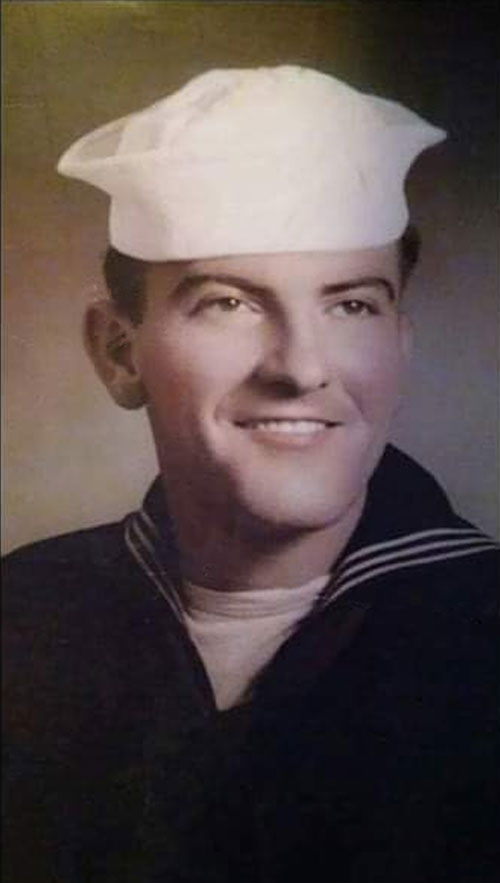
GM3 Howard Charles Dean, United States Navy. Undated Portrait Photo circa 1950. Photograph Courtesy of Charles Dean, 2021. | GGA Image ID # 19f333c0d8
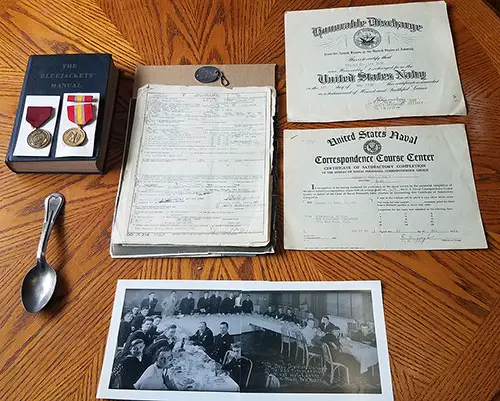
Assorted Military Papers, Awards, Bluejacket Manual, Photograph, etc., Pertaining to GM3 Howard Charles Dean, US Navy 1950-1954. Photo Courtesy of Charles Dean. | GGA Image ID # 19f33fa43c
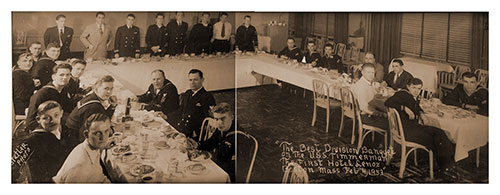
"The Best Division Banquet on the U.S.S. Timmerman The First Hotel Lenox Boston, Massachusetts, 4 February 1953." Image Courtesy of Charles Dean. | GGA Image ID # 19f3885416
Note 1: USS Timmerman (DD-828) was a Gearing-class destroyer in service with the United States Navy from 1952 to 1956. She was an experimental design and was scrapped in 1959. The ship was named after Grant F. Timmerman, born on 14 February 1919 in Americus, Kansas, and enlisted in the United States Marine Corps on 28 October 1937. Before World War II, he served at various Marine Corps posts and stations on the West Coast and in China.
Sergeant Timmerman participated in the invasion and capture of Tarawa in November 1943 as a member of the 2nd Marine Division. In June and July 1944, he served as a tank commander with the 2nd Battalion, 6th Marines, against enemy Japanese forces on Saipan. Sergeant Timmerman was awarded the Bronze Star Medal for his conduct on 15 and 16 June 1944. His citation reads: "Continuously exposed to shattering blasts from Japanese mortars during the hazardous night and day landing operations, Sergeant Timmerman steadfastly operated his gun and delivered vigorous, accurate fire against bitter enemy counterattacks, thereby assisting vitally in the maintenance of our position."
Sergeant Timmerman was posthumously awarded the Medal of Honor for conspicuous gallantry and intrepidity at the risk of his life during action against Japanese forces on 8 July 1944. "Advancing with his tank a few yards ahead of the infantry in support of a vigorous attack on hostile positions, Sergeant Timmerman maintained steady fire from his antiaircraft sky mount machinegun until a series of enemy trenches and pillboxes impeded progress.
Observing a target of opportunity, he immediately ordered the tank to stop and, mindful of the danger from the muzzle blast, prepared to open fire with the 75-mm. [gun] fearlessly stood up in the turret and ordered the infantry to hit the deck. Quickly acting as a grenade hurled by the Japanese, it was about to drop into the open turret hatch.
Sergeant Timmerman unhesitatingly blocked the opening with his body, holding the grenade against his chest and taking the brunt of the explosion. His exceptional valor and loyalty in saving his men at the cost of his own life reflect the highest credit upon Sergeant Timmerman and the United States Naval Service. He gallantly gave his life in the service of his country."
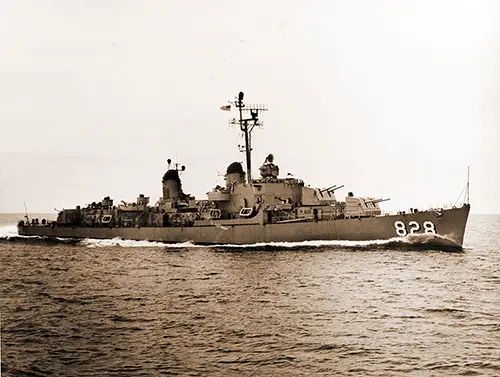
The USS Timmerman (DD-828) Shown Underway off the Coast of Newport, RI 10 July 1953. Note the Various Non-standard Features of This Experimental Destroyer. US Navy Official Photo 80-G-625700 US Naval History and Heritage Command. | GGA Image ID # 19f35936ad
Timmerman (DD-828) was laid down on 1 October 1954 at Bath, Maine, by the Bath Iron Works; assigned to the Atlantic Reserve Fleet on 19 November 1945; launched on 19 May 1951; sponsored by Mrs. Fred Timmerman; and commissioned on 26 September 1952, Comdr. Edward E. Hoffman in command.
Timmerman was constructed as an experimental, lightweight, advanced-design destroyer to test and evaluate, under operating conditions, advanced design experimental engineering equipment. As a unit of the Operational Development Force, 1st Naval District, Boston, she tested her new propulsion system for the next four years. On 11 January 1954, the US Navy changed its designation to AG-152, a miscellaneous auxiliary ship.
An Experimental Ship, USS Timmerman (EDD-828), is a testing ground for radical advances in main propulsion and electrical installations. Timmerman is not meant to be a prototype. Exact "look-alike" sister ships will never be built. Timmerman's value to the Navy will lie in lessons to be learned from weight-reducing, speed-increasing trials to be conducted. -- All Hands Magazine, September 1953.
The ship was decommissioned in Boston on 27 July 1956. She was moved to Philadelphia in September and assigned to the Reserve Fleet. In early 1958, Timmerman was declared unfit for further service and struck from the Navy list on 4 April 1958. On 21 April 1959, she was sold to the Boston Metals Co., Baltimore, Md., and scrapped.
- NavSource (Edited by GG Archives)
The Philadelphia Experiment and the USS Timmerman
Personnel at the Fourth Naval District believe the questions surrounding the so-called "Philadelphia Experiment" arise from relatively routine research during World War II at the Philadelphia Naval Shipyard.
Until recently, it was believed that the foundation for the apocryphal stories arose from degaussing experiments that made a ship undetectable or "invisible" to magnetic mines.
Another likely genesis of the bizarre stories about levitation, teleportation, and effects on human crew members might be attributed to experiments with the generating plant of a destroyer, the USS Timmerman.
In the 1950s, this ship was part of an experiment to test the effects of a small, high-frequency generator providing 1,000hz instead of the standard 400hz.
The higher-frequency generator produced corona discharges and other well-known phenomena associated with high-frequency generators. None of the crew suffered effects from the experiment.
Sourced from the Department of the Navy, Office of Naval Research Information Sheet: "Philadelphia Experiment." 08 September 1996

